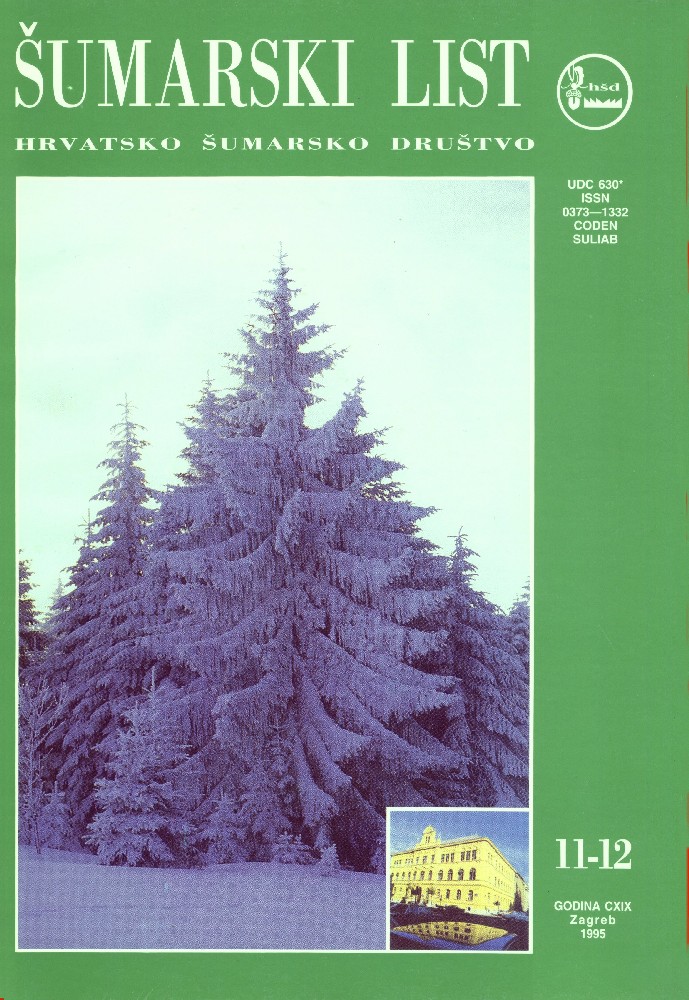
broj: 11-12/1995
pdf (17,2 MB) |
|
||||||||||||||
| IZVORNI ZNANSTVENI ČLANCI | ||
| Klepac, D. | UDK 630*5.56(001) Abies Alba Mill. | |
| The Fluctuations in Growing Stock of the Silver Fir Beech Selection Forests in the Region of Gorski Kotar pdf HR EN | 359 | |
| Tikvić, I., Seletković, Z., Anić, I. | UDK 630*425.9(001) | |
| Forest Dieback as a Manifestation of the Ecological Changes in the Atmosphere pdf HR EN | 361 | |
| Brna, J., Manojlović, L., Forgić, M., Urošević, B. | UDK 630*639.1(001/2) Sus scrofa L. | |
| Investigation of Methods of Pairing Wild Boar Sexes Influencing the Dynamics of Bearing in Fenced Hunting Ground pdf HR EN | 373 | |
| Mayer, B. | UDK 630*116(001) | |
| Scope and Meaning of the Ground and Surface Water Monitoring for the Lowland Forests in Croatia pdf HR EN | 383 | |
| PRETHODNO PRIOPĆENJE | ||
| Krpan, A. P. B., Govorčin, S., Sinković, T. | UDK 630*425+812(001) Abies Alba Mill. | |
| Determination of some Physical and Mechanical Properties and quality of Demeged Fir (Abies Alba Mill.) Trees pdf HR EN | 391 | |
| Summary: Since 1950, when it was first observed in their native areal, the dying of fir forests has been on the increase. It has been confirmed by observing the percentage of the growing-stock increment. In the Zalesina forests management unit Kupjački Vrh, the increment percentage was 1.9% in 1951/52; in 1994/95 it fell to 0.62%. Owing to the significance of the phenomenon, in 1968 started a research project on the fir and oak forest dieback. The so far accomplished work has revealed the complex interactions of climatological, ecological, pedological, biological and antropogeneous factors influencing the fir forests. The last blow to the physiologically weakened trees was given by bark-beetles. The aim of this paper is to establish the probable links between the reductions of the fir crown assimilation system with the change of the physical and mechanical properties of wood. Three fir trees with the degrees of damage 0, 1 and 3 were chosen according to the criteria of the European Community Forestry Commission. Test samples were taken for establishing the physical and mechanical properties according to the valid standards. The research reveals that the established values of the physical and mechanical properties do not correspond to the damage degree of the fir crown. Neither has been established the expected fall of the analyzed properties as shown on the outer annual rings of the dmaged trees. The conclusion was that the damage of the fir crowns has not made an impact on the physical and mechanical properties of the wood. The quality and practical use value of the firwood have not been affected either. Colour change of the sawmill logs did not affect the quality classification. | ||
| STRUČNI ČLANCI | ||
| Prpić, B. | UDK 630*907.11 | |
| Forest Ecosystem Status in the Plitvička Jezera National Park in the Aftermath of Serbian Occupation PDF | 407 | |
| Meštrović, Š. | UDK 630* | |
| Instructions for Forest Management pdf HR EN | 409 | |
| IZ POVIJESTI ŠUMARSTVA | ||
| Hranilović, S., Piškorić, O. | UDK 630*902.1 | |
| The Contribution of Croatian Foresters to Argentinian Forestry - With a Biography of Six Foresters pdf HR EN | 415 | |


